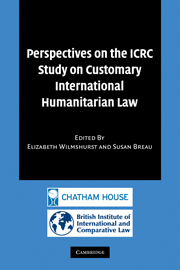Book contents
- Frontmatter
- Contents
- Preface
- List of contributors
- Table of cases
- Table of treaties and other instruments
- Abbreviations
- Part 1 Setting the scene: Theoretical perspectives on international law in the ICRC Study
- Part 2 The status of conflict and combatants: The ICRC Study
- Part 3 Commentary on selected Rules from the ICRC Study
- 6 The law of targeting
- 7 Protected persons and objects
- 8 Natural environment
- 9 Specific methods of warfare
- 10 Weapons, means and methods of warfare
- 11 Fundamental guarantees
- 12 Status and treatment of prisoners of war and other persons deprived of their liberty
- 13 Displacement and displaced persons
- 14 Implementation and compliance
- 15 War crimes
- Part 4 Conclusions
- Index
13 - Displacement and displaced persons
Published online by Cambridge University Press: 09 July 2009
- Frontmatter
- Contents
- Preface
- List of contributors
- Table of cases
- Table of treaties and other instruments
- Abbreviations
- Part 1 Setting the scene: Theoretical perspectives on international law in the ICRC Study
- Part 2 The status of conflict and combatants: The ICRC Study
- Part 3 Commentary on selected Rules from the ICRC Study
- 6 The law of targeting
- 7 Protected persons and objects
- 8 Natural environment
- 9 Specific methods of warfare
- 10 Weapons, means and methods of warfare
- 11 Fundamental guarantees
- 12 Status and treatment of prisoners of war and other persons deprived of their liberty
- 13 Displacement and displaced persons
- 14 Implementation and compliance
- 15 War crimes
- Part 4 Conclusions
- Index
Summary
Introduction
The displacement of people from their homes, regions and even their countries is a common feature of armed conflicts. Indeed the manner in which armed conflicts are conducted makes it almost inevitable: battles are fought not apart from the civilian population but frequently amongst it and even against it. This means that civilians may be forced to flee a conflict simply in order to save their own lives, leaving their homes and often their possessions unattended, at the mercy of those who remain behind or of incoming combatants and civilians. The picture is, however, even bleaker when one considers that civilians may be deliberately displaced by the threat or use of force, either as a means simply of weakening the other side, or else as part of a wider, longer-term strategy to alter the ethnic composition of a particular territory.
Displacement occurs during both international and non-international armed conflicts. In either case those affected may find themselves either outside the territory of their own State (in which case they may be considered refugees in the wider sense of the term), or else in another area of their own State, in which case they are generally referred to as internally displaced persons (IDPs).
- Type
- Chapter
- Information
- Publisher: Cambridge University PressPrint publication year: 2007



